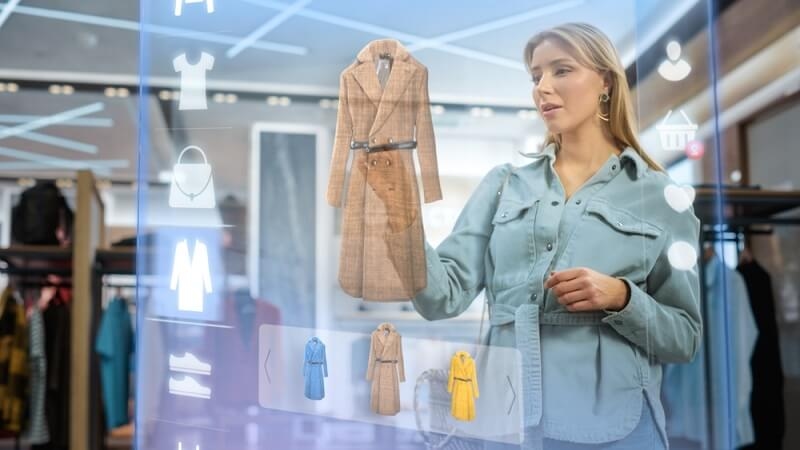
Changes are happening in the fashion industry at a rapid pace, and technology is leading the movement. Be it virtual wearable to robotic designed clothing; everything is being redefined in the way we present ourselves and how we enjoy fashion. In this blog, we are going to see how digital fashion 2025 can be used to develop trends, shopping experience, and even our online persona.
Digital fashion 2025 is the clothing and experience of fashion in digital contexts. Clothing as an object no longer exists in the real world only; it extends even to avatars on social media or metaverse shows.
Digital fashion is the digital version of clothes. They come in the form of online clothes that one can use in photographs, games, or in virtual spaces. Comparable to the filters that you have on your phone, one can apply or attach digital clothes to your image, and these clothes have never been stitched or sewn at any time.
Nowadays, we live in the era of information; in 2025, people will spend more time online than ever. We are creating digital avatars of the self through games and social media to virtual reality (VR) and the metaverse. Virtual clothes assist individual in portraying their identity in such places. It is entertaining, rapid, and environmentally friendly as well.
Unlike old-school clothing, there is no fabric, no shipping required to make digital fashion. This conserves these resources and wastes are cuts down. It is significantly quicker, too; the designers can create and post new designs in minutes rather than in weeks.
With the help of smart technology, the fashion world is undergoing a digital transformation. These new tools are not only making production easier but also improving customer experience.
Designers now use 3D software to create virtual outfits that can be viewed from all angles. Tools like CLO 3D and Marvelous Designer let them simulate fabric movement and body fitting digitally.
Ever wanted to try on clothes without leaving your house? Thanks to fashion technology, you can! Augmented reality (AR) lets users try on clothes using just a smartphone camera. This helps reduce online returns and makes shopping more fun.
Technology is also going into the clothes themselves. Smart fabrics can adjust to temperature, track your health, or even light up. In 2025, fashion technology means your outfit could be part of your wellness plan.
AI in fashion is changing everything—from how clothes are designed to how we shop. Artificial intelligence helps brands understand trends, create new styles, and personalize recommendations.
Designers are now working with AI tools that generate ideas based on user data, fashion history, and trend forecasts. This helps them create more relevant and on-trend collections in less time.
AI tracks your preferences and browsing history to suggest outfits you’ll like. It's like having a personal stylist available 24/7, helping you discover new looks based on your style and size.
AI also helps brands manage inventory better. It predicts how many items will sell, reducing overproduction. This is great for the environment and helps fight fashion waste.

In digital fashion 2025, wearing clothes online is just as important as in real life. Virtual clothing allows users to try bold styles without buying physical items—and it's becoming a global trend.
Virtual clothing is designed for your digital self. These are outfits you can wear in games, AR filters, or social media photos. They don’t exist physically, but they look realistic on screens.
You can upload a photo, and digital stylists will “dress” you in a virtual outfit. Some apps even let you see the clothes in motion, adjusting to your body and movements in real time.
Big brands like Gucci, Balenciaga, and Nike are already selling virtual clothes. Some items are designed just for avatars in platforms like Roblox, Fortnite, or Meta’s virtual worlds.
Suggested reading: Chic & Comfy: Master Work-from-Home Style with Zero Effort
In 2025, the fashion runway isn’t just in Paris or Milan—it’s online. Social media, gaming platforms, and the metaverse are now key places where fashion trends start.
Games like Fortnite and The Sims let players digitally dress their characters. In some cases, these looks are sold for real money. Gaming and fashion have joined hands to offer exciting style experiences.
During fashion weeks, many designers now host virtual fashion shows. You can watch them using VR or on your phone. Some even let you try on the clothes virtually right after the show.
With growing concerns about pollution and waste, digital fashion 2025 offers a sustainable alternative. It helps brands and users lower their carbon footprint while staying stylish.
Designers can create and test multiple looks digitally without using fabric. This means fewer samples, less waste, and smarter production choices.
When people can try on clothes virtually and see how they fit, they're less likely to return them. This reduces transportation emissions and wasted inventory.
Also read: Everyday Athleisure Outfits That Blends Style and Comfort
While digital fashion 2025 is exciting, it’s not without problems. From digital access to cost, some issues still need to be solved.
Looking forward, digital fashion 2025 is just the beginning. As technology improves, so will the experiences, creativity, and usefulness of fashion in digital spaces.
Digital fashion 2025 is not only a trend, but it is a revolution. The introduction of fashion technology, AI in fashion, and a cloth in a virtual form helps us enter the new age of convenience and creativity. No matter who or what is making you shop, fashion is never this exciting at any time in history... and probably never smarter either. Digital and real boundaries will continue blurring as we go on. The future fashion is not a garment, but the experience.
This content was created by AI